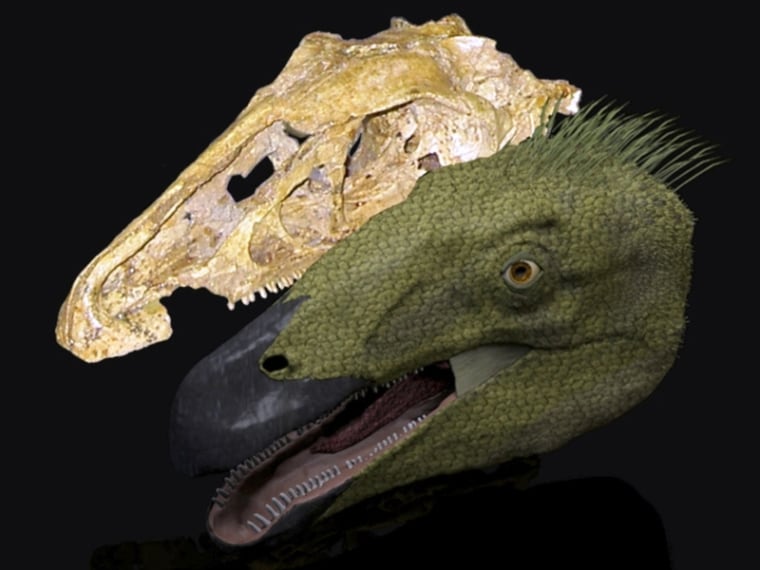Like their birdie descendants, some types of dinosaurs had beaks — but what good were they? X-ray fossil scans and computer modeling suggest that those beaks stabilized the Cretaceous creatures' skulls while they were gobbling down their food.
The results are laid out in a study published Monday in the Proceedings of the National Academy of Sciences. Researchers scanned the skull of Erlikosaurus andrewsi, a plant-eating dinosaur that lived more than 90 million years ago in present-day Mongolia. The snout of the 10- to 13-foot-long (3- to 4-meter-long) therizinosaur is thought to have been partly covered with a keratinous beak. Keratin is a tough material that's found in the beaks of birds and turtles as well as in horns, nails, claws and hooves.
The researchers' X-ray scans were used to produce a 3-D model of the skull that could be virtually manipulated to see how it would stand up to stresses. "We were able to deduce very accurately how bite and muscle forces affected the skull of Erlikosaurus during the feeding process," University of Bristol paleontologist Emily Rayfield said in a news release. "This further allowed us to identify the importance of soft-tissue structures, such as the keratinous beak, which are normally not preserved in fossils."
She and her colleagues found that the presence of a beak made the skull less susceptible to bending and deformation.
"It has classically been assumed that beaks evolved to replace teeth and thus save weight, as a requirement for the evolution of flight," said the study's lead author, Stephan Lautenschlager of the University of Bristol. "Our results, however, indicate that keratin beaks were in fact beneficial to enhance the stability of the skull during biting and feeding."
Another co-author, Lawrence Witmer of the Ohio University Heritage College of Osteopathic Medicine, noted that beaks apparently evolved several times during the transition from dinosaurs to modern birds. Usually the shift to beaks was accompanied by the partial or complete loss of teeth. "Our study now shows that keratin-covered beaks represent a functional innovation during dinosaur evolution," Witmer said in the news release.
The latest findings appear to support findings published in 2010, which suggested that having beaks expanded the dietary choices for some types of dinosaurs — in particular, aiding in the shift from a carnivorous to a herbivorous diet.
More about therizinosaurs:
- Odd-looking dinosaur caught in the act of evolution
- Nests of bizarre, big-clawed dinosaurs unearthed
- Long-necked, waddling dinosaur discovered
Authors of the PNAS study, "Edentulism, Beaks and Biomechanical Innovations in the Evolution of Theropod Dinosaurs," include Lautenschlager, Witmer, Rayfield and Perle Altangerel. The study was funded by a research fellowship to Lautenschlager from the German Volkswagen Foundation and grants from the National Science Foundation to Lawrence Witmer.
Alan Boyle is NBCNews.com's science editor. Connect with the Cosmic Log community by "liking" the log's Facebook page, following @b0yle on Twitter and adding the Cosmic Log page to your Google+ presence. To keep up with Cosmic Log as well as NBCNews.com's other stories about science and space, sign up for the Tech & Science newsletter, delivered to your email in-box every weekday. You can also check out "The Case for Pluto," my book about the controversial dwarf planet and the search for new worlds.
